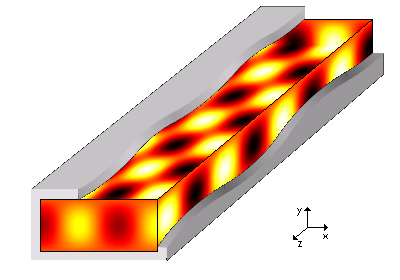Currently Dr. Zou’s group is experimenting with wave guide, surface Plasmon models and light simulations. They are designing structures of silver and gold for the purpose of directing, transmitting and absorbing electromagnetic waves. Their DDA software allows them to test their computer engineered design computationally, that is, with a simulation.
Waveguides
You know what a waveguide is. Have you ever heard of fiber optics? Well the fiber is a waveguide that the light wave travels on. The analogy that I think of is the sound waves traveling along the string between two cans. In the research group they are designing NANO waveguides. These structures are 10-100 nm in length. They are made of material that contain surface plasmons and they are trying to optimize the distance a light wave will travel without diminishing the energy of the wave. If an electric field can be directed through a path of air then the refractive index of waveguide materials like wire or glass would not slow down it’s travel. Also, engineering waveguides in nano scale will allow circuitry components to become much smaller.

 The research group tested three different length silver nanotubes. These computer engineered tubes were 100 x 60 nm2 and had a hollow core with a diameter of 80 x 40 nm2 . This picture illustrates the movement of light waves in three different lengths of silver nanotubes. The intensity of the electric field at X = O is 1. As you can see in all three silver nanotubes, the intensity of the electric field was 100 times greater at the end of the tube. These findings bode well for waveguides built with these parameters.
The research group tested three different length silver nanotubes. These computer engineered tubes were 100 x 60 nm2 and had a hollow core with a diameter of 80 x 40 nm2 . This picture illustrates the movement of light waves in three different lengths of silver nanotubes. The intensity of the electric field at X = O is 1. As you can see in all three silver nanotubes, the intensity of the electric field was 100 times greater at the end of the tube. These findings bode well for waveguides built with these parameters.

Nanofilms and Particles
You’ve seen nanoparticles in use before. Nanoparticles have been used since ancient times for their transmitting and light scattering properties. Everyone describes a nanoparticle as being the size of a molecule. How big is a molecule anyway? Obviously, depending on the molecule they range in size but in general a particle of dust is about the half way point between the size of the earth and the size of a molecule. The ancient Romans did not know what surface plasmons were but they knew that they created beautiful colors in their glass, ceramics and art.


The research group digitally fabricated different shaped nano particles as you can see by the graph. Once fabricated they simulated tests involving direction of visible wavelengths of light at the particles and determining which wavelengths absorbed and which transmitted. The extinction efficiency is the sum of absorption and scattering. Wavelengths not absorbed or scattered are transmitted. Transmitted wavelengths give the particles the appearance of color.

